2012年青岛科技大学825材料力学考研真题硕士研究生专业课考试试题
- 格式:pdf
- 大小:131.96 KB
- 文档页数:5
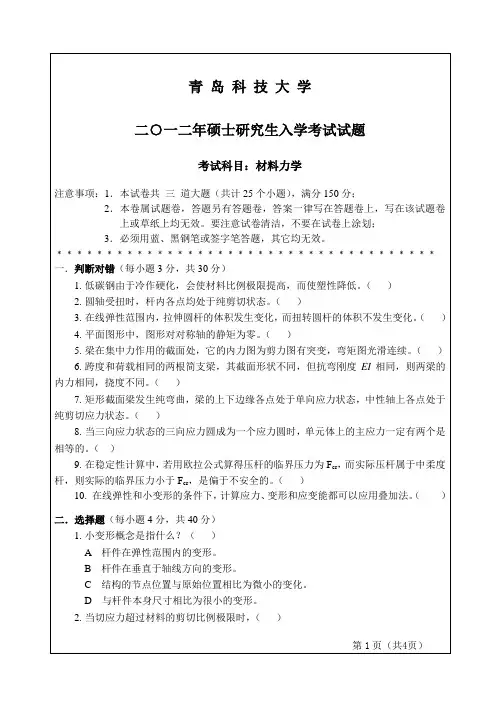
青岛科技大学二○一二年硕士研究生入学考试试题考试科目:材料力学注意事项:1.本试卷共三道大题(共计25个小题),满分150分;2.本卷属试题卷,答题另有答题卷,答案一律写在答题卷上,写在该试题卷上或草纸上均无效。
要注意试卷清洁,不要在试卷上涂划;3.必须用蓝、黑钢笔或签字笔答题,其它均无效。
﹡﹡﹡﹡﹡﹡﹡﹡﹡﹡﹡﹡﹡﹡﹡﹡﹡﹡﹡﹡﹡﹡﹡﹡﹡﹡﹡﹡﹡﹡﹡﹡﹡﹡﹡﹡﹡﹡一.判断对错(每小题3分,共30分)1.低碳钢由于冷作硬化,会使材料比例极限提高,而使塑性降低。
()2.圆轴受扭时,杆内各点均处于纯剪切状态。
()3.在线弹性范围内,拉伸圆杆的体积发生变化,而扭转圆杆的体积不发生变化。
()4.平面图形中,图形对对称轴的静矩为零。
()5.梁在集中力作用的截面处,它的内力图为剪力图有突变,弯矩图光滑连续。
()6.跨度和荷载相同的两根简支梁,其截面形状不同,但抗弯刚度EI相同,则两梁的内力相同,挠度不同。
()7.矩形截面梁发生纯弯曲,梁的上下边缘各点处于单向应力状态,中性轴上各点处于纯剪切应力状态。
()8.当三向应力状态的三向应力圆成为一个应力圆时,单元体上的主应力一定有两个是相等的。
()9.在稳定性计算中,若用欧拉公式算得压杆的临界压力为F cr,而实际压杆属于中柔度杆,则实际的临界压力小于F cr,是偏于不安全的。
()10. 在线弹性和小变形的条件下,计算应力、变形和应变能都可以应用叠加法。
()二.选择题(每小题4分,共40分)1.小变形概念是指什么?()A 杆件在弹性范围内的变形。
B 杆件在垂直于轴线方向的变形。
C 结构的节点位置与原始位置相比为微小的变化。
D 与杆件本身尺寸相比为很小的变形。
2.当切应力超过材料的剪切比例极限时,()1第页(共4页)。
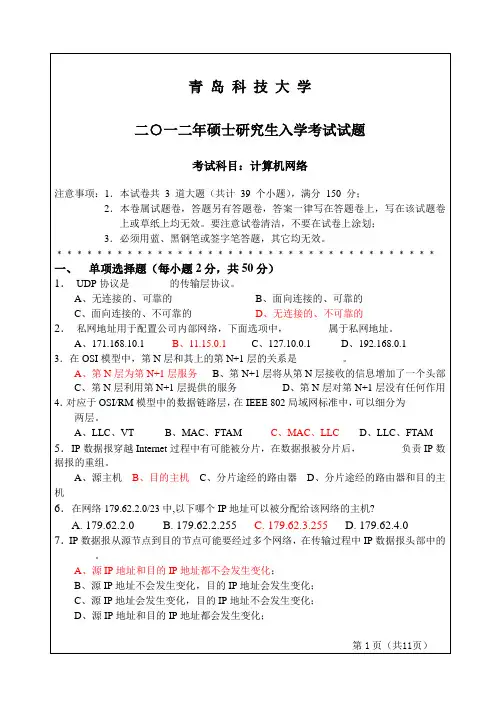
不归零码(NRZ,Not Return to Zero)数字信号可以直接采用基带传输,所谓基带就是指基本频带。
基带传输就是在线路中直接传送数字信号的电脉冲,这是一种最简单的传输方式,近距离通信的局域网都采用基带传输。
基带传输时,需要解决数字数据的数字信号表示以及收发两端之间的信号同步问题。
对于传输数字信号来说,最简单最常用的方法是用不同的电压电平来表示两个二进制数字,也即数字信号由矩形脉冲组成。
按数字编码方式,可以划分为单极性码和双极性码,单极性码使用正(或负)的电压表示数据;双极性码是二进制码,1为反转,0为保持零电平。
根据信号是否归零,还可以划分为归零码和非归零码,归零码码元中间的信号回归到0电平,而非归零码遇1电平翻转,零时不变。
常见的几种基本的数字信号脉冲编码方案如下:单极性不归零码,无电压(也就是无电流)用来表示"0",而恒定的正电压用来表示"1"。
每一个码元时间的中间点是采样时间,判决门限为半幅度电平(即0.5)。
也就是说接收信号的值在0.5与1.0之间,就判为"1"码,如果在0与0.5之间就判为"0"码。
每秒钟发送的二进制码元数称为"码速"。
双极性不归零码,"1"码和"0"码都有电流,但是"1"码是正电流,"0"码是负电流,正和负的幅度相等,故称为双极性码。
此时的判决门限为零电平,接收端使用零判决器或正负判决器,接收信号的值若在零电平以上为正,判为"1"码;若在零电平以下为负,判为"0"码。
以上两种编码,都是在一个码元的全部时间内发出或不发出电流(单极性),以及发出正电流或负电流(双极性)。
每一位编码占用了全部码元的宽度,故这两种编码都属于全宽码,也称作不归零码NRZ (Non Return Zero)。
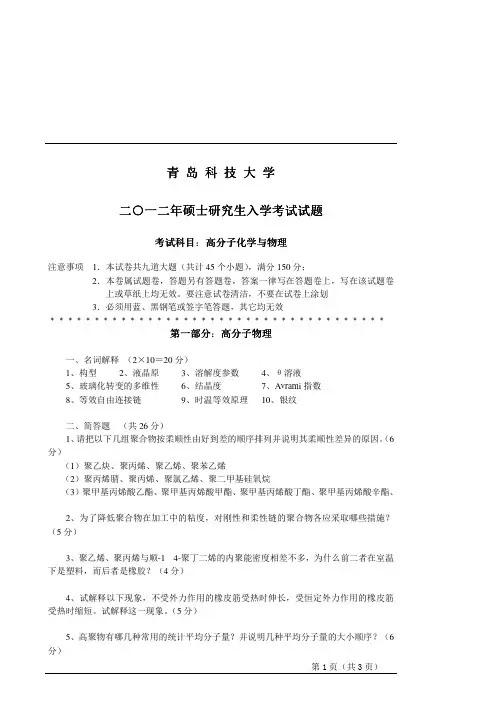
青岛科技大学二○一二年硕士研究生士研究生入学考入学考入学考试试试题考试科目考试科目:高分子化学与物理高分子化学与物理注意事项1.本试卷共九道大题(共计45个小题),满分150分;2.本卷属试题卷,答题另有答题卷,答案一律写在答题卷上,写在该试题卷上或草纸上均无效。
要注意试卷清洁,不要在试卷上涂划3.必须用蓝、黑钢笔或签字笔答题,其它均无效﹡﹡﹡﹡﹡﹡﹡﹡﹡﹡﹡﹡﹡﹡﹡﹡﹡﹡﹡﹡﹡﹡﹡﹡﹡﹡﹡﹡﹡﹡﹡﹡﹡﹡﹡﹡﹡﹡第一部分第一部分:高分子物理高分子物理一、名词解释(2×10=20分)1、构型2、液晶原3、溶解度参数4、θ溶液5、玻璃化转变的多维性6、结晶度7、Avrami 指数8、等效自由连接链 9、时温等效原理 10、银纹二、简答题 (共26分)1、请把以下几组聚合物按柔顺性由好到差的顺序排列并说明其柔顺性差异的原因。
(6分)(1)聚乙炔、聚丙烯、聚乙烯、聚苯乙烯(2)聚丙烯腈、聚丙烯、聚氯乙烯、聚二甲基硅氧烷(3)聚甲基丙烯酸乙酯、聚甲基丙烯酸甲酯、聚甲基丙烯酸丁酯、聚甲基丙烯酸辛酯、2、为了降低聚合物在加工中的粘度,对刚性和柔性链的聚合物各应采取哪些措施?(5分)3、聚乙烯、聚丙烯与顺-14-聚丁二烯的内聚能密度相差不多,为什么前二者在室温下是塑料,而后者是橡胶?(4分)4、试解释以下现象,不受外力作用的橡皮筋受热时伸长,受恒定外力作用的橡皮筋受热时缩短。
试解释这一现象。
(5分)5、高聚物有哪几种常用的统计平均分子量?并说明几种平均分子量的大小顺序?(6分)三、请分别画出MAXWELL 模型和 KELVIN 模型,说明它们分别可以模拟什么类型聚合物的哪种力学松弛过程并写出相应的运动方程。
(14分)四、某α-烯烃的平均聚合度为500,实测的无扰均方末端距为22)25(nm h =θ试求1、刚性因子σ2、作为高分子独立运动单元的链段长度b3、每个高分子链包含的平均链段数N4、每个统计链段包含的重复结构单元数。
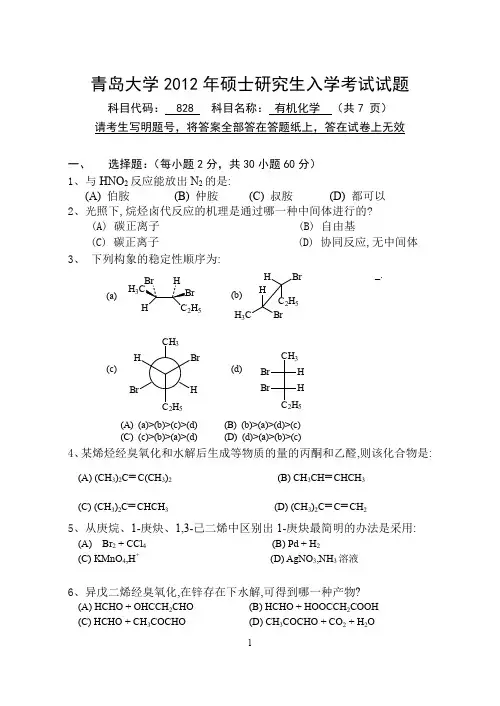
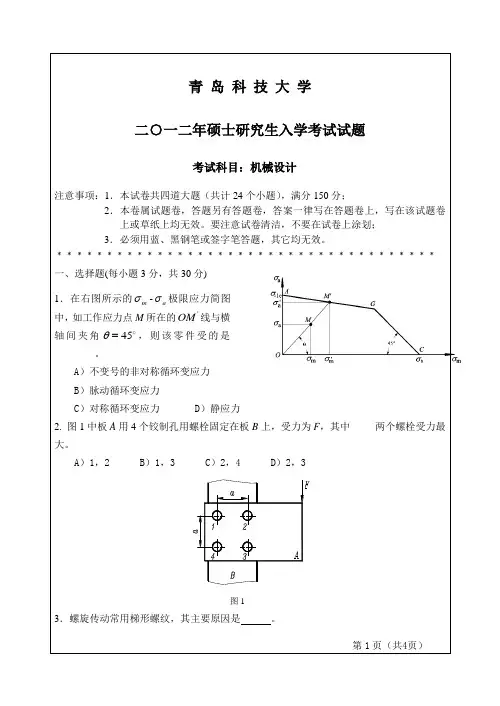
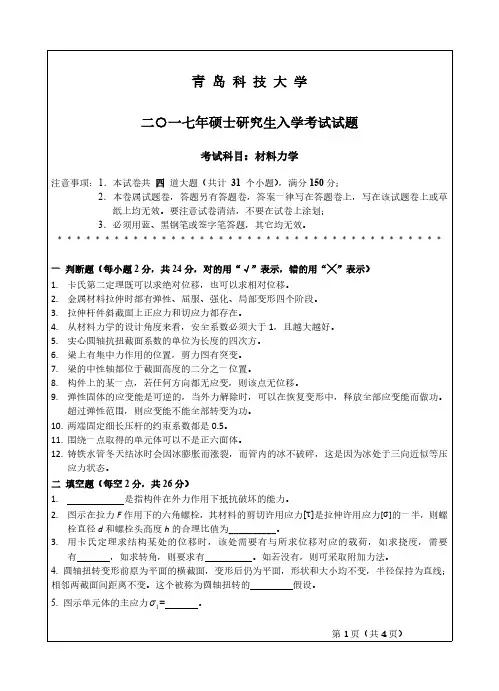
青岛科技大学二○一七年硕士研究生入学考试试题考试科目:材料力学注意事项:1.本试卷共四道大题(共计31 个小题),满分150分;2.本卷属试题卷,答题另有答题卷,答案一律写在答题卷上,写在该试题卷上或草纸上均无效。
要注意试卷清洁,不要在试卷上涂划;3.必须用蓝、黑钢笔或签字笔答题,其它均无效。
﹡﹡﹡﹡﹡﹡﹡﹡﹡﹡﹡﹡﹡﹡﹡﹡﹡﹡﹡﹡﹡﹡﹡﹡﹡﹡﹡﹡﹡﹡﹡﹡﹡﹡﹡﹡﹡﹡﹡﹡﹡一判断题(每小题2分,共24分,对的用“√”表示,错的用“╳”表示)1. 卡氏第二定理既可以求绝对位移,也可以求相对位移。
2. 金属材料拉伸时都有弹性、屈服、强化、局部变形四个阶段。
3. 拉伸杆件斜截面上正应力和切应力都存在。
4. 从材料力学的设计角度来看,安全系数必须大于1,且越大越好。
5. 实心圆轴抗扭截面系数的单位为长度的四次方。
6. 梁上有集中力作用的位置,剪力图有突变。
7. 梁的中性轴都位于截面高度的二分之一位置。
8. 构件上的某一点,若任何方向都无应变,则该点无位移。
9. 弹性固体的应变能是可逆的,当外力解除时,可以在恢复变形中,释放全部应变能而做功。
超过弹性范围,则应变能不能全部转变为功。
10. 两端固定细长压杆的约束系数都是0.5。
11. 围绕一点取得的单元体可以不是正六面体。
12. 铸铁水管冬天结冰时会因冰膨胀而涨裂,而管内的冰不破碎,这是因为冰处于三向近似等压应力状态。
二填空题(每空2分,共26分)1. 是指构件在外力作用下抵抗破坏的能力。
[τ]σ2. 图示在拉力F作用下的六角螺栓,其材料的剪切许用应力是拉伸许用应力[]的一半,则螺栓直径d和螺栓头高度h的合理比值为__________。
3. 用卡氏定理求结构某处的位移时,该处需要有与所求位移对应的载荷,如求挠度,需要有,如求转角,则要求有。
如若没有,则可采取附加力法。
4. 圆轴扭转变形前原为平面的横截面,变形后仍为平面,形状和大小均不变,半径保持为直线;相邻两截面间距离不变。
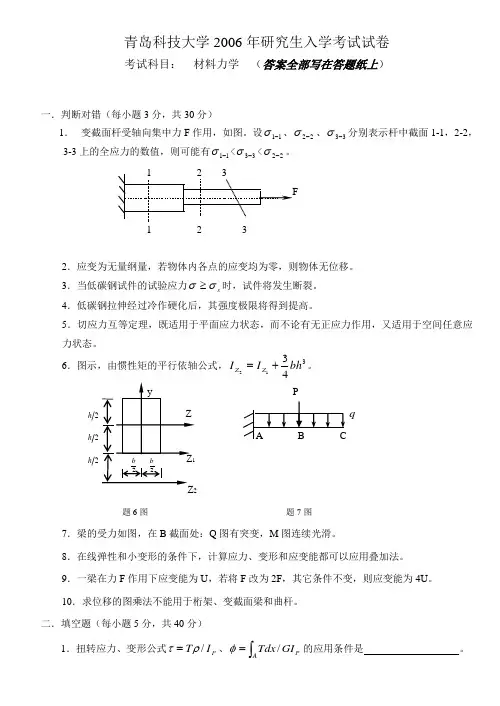
青岛科技大学2006年研究生入学考试试卷考试科目: 材料力学 (答案全部写在答题纸上)一.判断对错(每小题3分,共30分)1. 变截面杆受轴向集中力F 作用,如图。
设11-σ、22-σ、33-σ分别表示杆中截面1-1,2-2,3-3上的全应力的数值,则可能有11-σ<33-σ<22-σ。
1 2 32.应变为无量纲量,若物体内各点的应变均为零,则物体无位移。
3.当低碳钢试件的试验应力s σσ≥时,试件将发生断裂。
4.低碳钢拉伸经过冷作硬化后,其强度极限将得到提高。
5.切应力互等定理,既适用于平面应力状态,而不论有无正应力作用,又适用于空间任意应力状态。
6.图示,由惯性矩的平行依轴公式,34312bh I I Z Z +=。
P2h q 2h 2h 2题6图 题7图 7.梁的受力如图,在B 截面处:Q 图有突变,M 图连续光滑。
8.在线弹性和小变形的条件下,计算应力、变形和应变能都可以应用叠加法。
9.一梁在力F 作用下应变能为U ,若将F 改为2F ,其它条件不变,则应变能为4U 。
10.求位移的图乘法不能用于桁架、变截面梁和曲杆。
二.填空题(每小题5分,共40分)1.扭转应力、变形公式P I T /ρτ=、⎰=APGITdx /φ的应用条件是 。
2.图示长度为l 等直梁承受均布载荷q 。
为使梁横截面内最大弯矩达到最小值,则对称放置的两支座的间距=a 。
qal3.两根梁尺寸、受力和支承情况完全相同,但材料不同,弹性模量分别为21217E E E E =,且和,则两根梁的挠度之比21:f f 为 。
4.图示梁,欲使跨度中点挠度为零,则P 与q 的关系为 。
q5.在线弹性结构中,外力F 在相应的位移Δ上所作的功,当 时,W=21F Δ;当 时,W=F Δ。
6.抗弯刚度为EI 的简支梁如图。
当梁只受1=F 作用时,截面A 的转角为EI L 16/2;当梁只受1=m 作用时,其跨度中点C 的挠度为 。
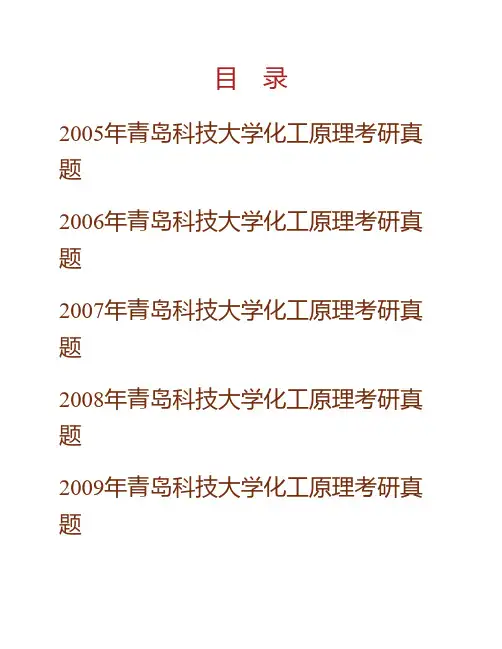
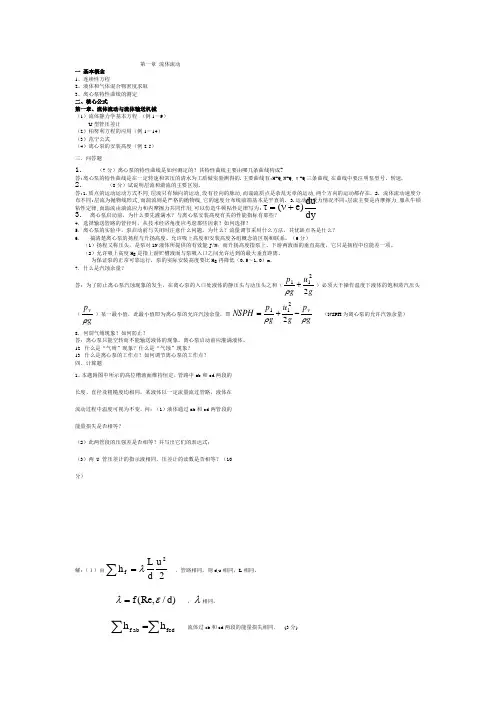
第一章 流体流动 一 基本概念 1、连续性方程2、液体和气体混合物密度求取3、离心泵特性曲线的测定 二、核心公式第一章、流体流动与流体输送机械(1)流体静力学基本方程 (例1-9)U 型管压差计(2)柏努利方程的应用(例1-14) (3)范宁公式(4)离心泵的安装高度(例2-5) 三.问答题1.(7分)离心泵的特性曲线是如何测定的?其特性曲线主要由哪几条曲线构成?答:离心泵的特性曲线是在一定转速和常压的清水为工质做实验测得的.主要曲线有:H-Q,N-Q,η-Q 三条曲线,在曲线中要注明泵型号、转速. 2. (8分)试说明层流和湍流的主要区别。
答:1.质点的运动运动方式不同,层流只有轴向的运动,没有径向的脉动,而湍流质点是杂乱无章的运动,两个方向的运动都存在. 2. 流体流动速度分布不同:层流为抛物线形式,而湍流则是严格的抛物线,它的速度分布线前端基本是平直的. 3.运动的受力情况不同:层流主要是内摩擦力,服从牛顿粘性定律,而湍流由湍流应力和内摩擦力共同作用,可以仿造牛顿粘性定律写为:dydu )e (+ν=τ 3. 离心泵启动前,为什么要先灌满水?与离心泵安装高度有关的性能指标有那些? 4.选择输送管路的管径时,从技术经济角度应考虑那些因素?如何选择?5.离心泵的实验中,泵启动前与关闭时注意什么问题,为什么?流量调节采用什么方法,其优缺点各是什么? 6. 搞清楚离心泵的扬程与升扬高度、允许吸上高度和安装高度各组概念的区别和联系。
(6分)(1)扬程又称压头,是泵对1N 液体所提供的有效能J/N ;而升扬高度指泵上、下游两液面的垂直高度,它只是扬程中位能差一项。
(2)允许吸上高度Hg 是指上游贮槽液面与泵吸入口之间允许达到的最大垂直距离。
为保证泵的正常可靠运行,泵的实际安装高度要比Hg 再降低(0.5~1.0)m 。
7.什么是汽蚀余量?答:为了防止离心泵汽蚀现象的发生,在离心泵的入口处液体的静压头与动压头之和(gu g p 2211+ρ)必须大于操作温度下液体的饱和蒸汽压头(gp v ρ)某一最小值,此最小值即为离心泵的允许汽蚀余量,即gp g u g p NSPH v ρρ-+=2211 (NSPH 为离心泵的允许汽蚀余量)8.何谓气缚现象?如何防止?答:离心泵只能空转而不能输送液体的现象。
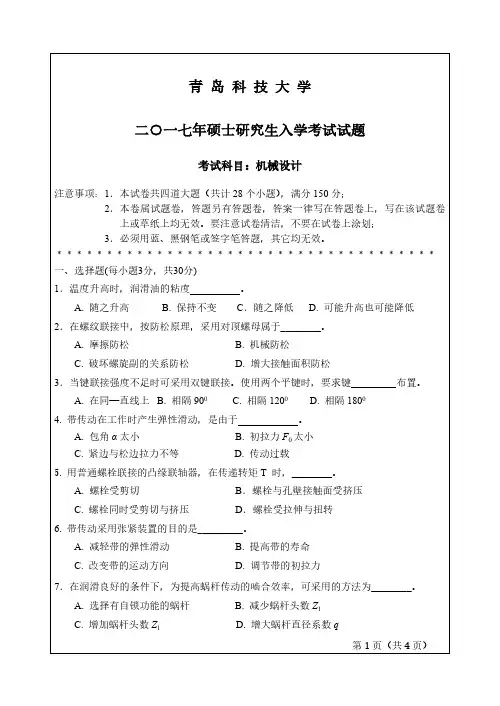
青岛科技大学二○一七年硕士研究生入学考试试题考试科目:机械设计注意事项:1.本试卷共四道大题(共计28个小题),满分150分;2.本卷属试题卷,答题另有答题卷,答案一律写在答题卷上,写在该试题卷上或草纸上均无效。
要注意试卷清洁,不要在试卷上涂划;3.必须用蓝、黑钢笔或签字笔答题,其它均无效。
﹡﹡﹡﹡﹡﹡﹡﹡﹡﹡﹡﹡﹡﹡﹡﹡﹡﹡﹡﹡﹡﹡﹡﹡﹡﹡﹡﹡﹡﹡﹡﹡﹡﹡﹡﹡﹡﹡一、选择题(每小题3分,共30分)1.温度升高时,润滑油的粘度。
A. 随之升高B. 保持不变C.随之降低 D. 可能升高也可能降低2.在螺纹联接中,按防松原理,采用对顶螺母属于________。
A. 摩擦防松B. 机械防松C. 破坏螺旋副的关系防松D. 增大接触面积防松3.当键联接强度不足时可采用双键联接。
使用两个平键时,要求键布置。
A. 在同—直线上B. 相隔900C. 相隔1200D. 相隔18004. 带传动在工作时产生弹性滑动,是由于。
A. 包角α太小B. 初拉力F0太小C. 紧边与松边拉力不等D. 传动过载5. 用普通螺栓联接的凸缘联轴器,在传递转矩T 时,________。
A. 螺栓受剪切B.螺栓与孔壁接触面受挤压C. 螺栓同时受剪切与挤压D.螺栓受拉伸与扭转6. 带传动采用张紧装置的目的是_________。
A. 减轻带的弹性滑动B. 提高带的寿命C. 改变带的运动方向D. 调节带的初拉力7.在润滑良好的条件下,为提高蜗杆传动的啮合效率,可采用的方法为________。
A. 选择有自锁功能的蜗杆B. 减少蜗杆头数Z1C. 增加蜗杆头数Z1D. 增大蜗杆直径系数q第页(共4页)1。
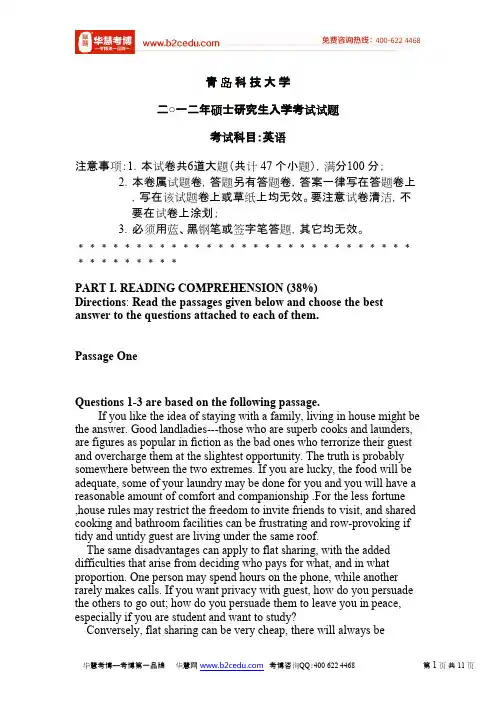
青岛科技大学二○一二年硕士研究生入学考试试题考试科目:英语注意事项:1.本试卷共6道大题(共计 47 个小题),满分100 分;2.本卷属试题卷,答题另有答题卷,答案一律写在答题卷上,写在该试题卷上或草纸上均无效。
要注意试卷清洁,不要在试卷上涂划;3.必须用蓝、黑钢笔或签字笔答题,其它均无效。
﹡﹡﹡﹡﹡﹡﹡﹡﹡﹡﹡﹡﹡﹡﹡﹡﹡﹡﹡﹡﹡﹡﹡﹡﹡﹡﹡﹡﹡﹡﹡﹡﹡﹡﹡﹡﹡﹡PART I. READING COMPREHENSION (38%)Directions: Read the passages given below and choose the best answer to the questions attached to each of them.Passage OneQuestions 1-3 are based on the following passage.If you like the idea of staying with a family, living in house might be the answer. Good landladies---those who are superb cooks and launders, are figures as popular in fiction as the bad ones who terrorize their guest and overcharge them at the slightest opportunity. The truth is probably somewhere between the two extremes. If you are lucky, the food will be adequate, some of your laundry may be done for you and you will have a reasonable amount of comfort and companionship .For the less fortune,house rules may restrict the freedom to invite friends to visit, and shared cooking and bathroom facilities can be frustrating and row-provoking if tidy and untidy guest are living under the same roof.The same disadvantages can apply to flat sharing, with the added difficulties that arise from deciding who pays for what, and in what proportion. One person may spend hours on the phone, while another rarely makes calls. If you want privacy with guest, how do you persuade the others to go out; how do you persuade them to leave you in peace, especially if you are student and want to study?Conversely, flat sharing can be very cheap, there will always besomeone to talk to and go out with, and the chores ,in theory, can beshared.1.According to the passage ,landladies are ________ ually strict. B. always mean. C. adequately competent. D. very popular with their guest.2.What is the additional disadvantage of flat sharing ? A. Problems of sharing and paying. B. Differences in living habits. C. Shared cooking and bathroom facilities. D. Restriction to invite friends to visit.3.What is NOT mentioned as a benefit of flat sharing? A. Rent is affordable B. There is companionship. C. Housework.D. There is peace and quiet.Passage TwoQuestions 4-8 are based on the following passage. I am afraid to sleep. I have been afraid to sleep for the last few weeks.I am so tired that, finally, I do sleep, but only for a few minutes. It is not abad dream that wakes me; it is the reality I took with me into sleep . I tryto think of something else. Immediately the woman in the marketplace comes into my mind. I was on my way to dinner last night when I saw her . She was sellingskirts. She moved with the same ease and loveliness I often saw in thewomen of Laos. Her long black hair was as shiny as the black silk of theskirts she was selling. In her hair, she wore three silk ribbons, blue, green,and white. They reminded me of my childhood and how my girlfriendsand I used to spend hours braiding ribbons into our hair. I don’t know the word for “ribbons”, so I put my hand to my own hairand , with three fingers against my head , I looked at her ribbons and said “Beautiful.” She lowered her eyes and said nothing. I wasn’t sure if sheunderstood me (I don’t speak Laotian very well). I looked back down at the skirts. They add designs in them: squaresand triangles and circles of pink and green silk. They were very pretty. Idecided to buy one of those skirts, and I began to bargain with her overthe price. It is the custom to bargain in Asia. In Laos bargaining is done in soft voices and easy moves with the sort of quiet peacefulness. She smiled, more with her eyes than with her lips. She was pleased by the few words I was able to say in her language, although they were mostly numbers, and she saw that I understood something about the soft playfulness of bargaining. We shook our heads in disagreement over the price; then, immediately, we made another offer and then another shake of the head. She was so pleased that unexpectedly, she accepted the last offer I made. But it was too soon. The price was too low. She was being too generous and wouldn’t make enough money. I moved quickly and picked up two more skirts and paid for all three at the price set; that way I was able to pay her three times as much before she had a chance to lower the price for the larger purchase. She smiled openly then, and, for the first time in months, my spirit lifted. I almost felt happy. The feeling stayed with me while she wrapped the skirts in a newspaper and handed them to me. When I left, though, the feeling left, too. It was as though it stayed behind in marketplace. I left tears in my throat. I wanted to cry. I didn’t , of course. I have learned to defend myself against what is hard; without knowing it, I have also learned to defend myself against what is soft and what should be easy. I get up, light a candle and want to look at the skirts. They are still in the newspaper that the woman wrapped them in. I remove the paper, and raise the skirts up to look at them again before I pack them. Something falls to floor. I reach down and feel something cool in my hand. I move close to the candlelight to see what I have. There are five long silk ribbons in my hand, all different colors. The woman in the marketplace! She has given these ribbons to me! There is no defense against a generous spirit, and this time I cry, and very hard, as if I could make up for all the months that I didn’t cry.4. Which of the following in NOT correct?A. The writer was not used to bargaining.B. People in Asia always bargain when buying things.C. Bargaining in Laos was quiet and peaceful.D. The writer was ready to bargain with the woman.5. The writer assumed that the woman accepted the last offer mainly because womanA. thought that the last offer was reasonable.B. thought she could still make much money.C. was glad that the writer knew their way of bargaining.D. was tired of bargaining with the writer any more.6. Why did the writer finally decide to buy three skirts?A. The skirts were cheap and pretty.B. She liked the patterns on the skirts.C. She wanted to do something as compensation.D. She was fed up with further bargaining with the woman.7. When did the writer left the marketplace, she wanted to cry, but did not becauseA. she had learned to stay cool and unfeeling.B. she was afraid of crying in public.C. she had learned to face difficulties bravely.D. she had to show in public that she was strong.8. Why did the writer cry eventually when she looked at the skirts again?A. she suddenly felt very sad.B. she liked the ribbons so much.C. she was overcome by emotion.D. she felt sorry for the woman.Passage ThreeQuestions 9-14 are based on the following passage.The kids are hanging out. I pass small bands of students, in my way to work these morings. They have become a familiar part of the summer landscape.These kids are not old enough for jobs. Nor are they rich enough for camp. They are school children without school. The calendar called the school year ran out on them a few weeks ago. Once supervised by teachers and principals, they now appear to be “self care”.Passing them is like passing through a time zone. For much of our history, after all, Americans arranged the school year around the needs of work and family. In 19th-century cities, schools were open seven or eight hours a day, 11 months a year. In rural America, the year was arranged around the growing season. Now, only 3 percent of families follow the agricultural model, but nearly all schools are scheduled as if our children went home early to milk the cows and took months off to work the crops. Now, three-quarters of the mothers of school-age children work, but the calendar is written as if they were home waiting for the school bus.The six-hour day, the 180-day school year is regarded as something holy. But when parents work an eight-hour day and a 240-day year, it means something different. It means that many kids go home to empty houses. It means that, in the summer, they hang out. “We have a huge mismatch between the school calendar and realities of family life,” says Dr. Ernest Boyer, head of the Carnegie Foundation for the Advancement of Teaching.Dr. Boyer is one of many who believe that a radical revision of the school calendar is inevitable."School, whether we like it or not, iseducational. It always has been.”His is not popular idea. School are routinely burdened with the job of solving all our social problems. Can they be asked to meet the needs of our work and family lives?It may be easier to promote a linger school year on its educational merits and, indeed, the educational case is compelling. Despite the complaints and studies about our kids’ lack of learning, the United State still has a shorter school year than any industrial nation. In most of Europe, the school year is 220 days. In Japan, it is 240 days long. While classroom time alone doesn’t produce a well-educated child, learning takes time and more learning takes more time. The long summers of forgetting take a toll.The opposition to a longer school year comes from families that want to and can provide other experiences for their children. It comes from teachers. It comes from tradition. And surely from kids. But the most important part of the conflict has been over the money.9. Which of the following is an opinion of the author’s?A."The kids are hanging out.”B."They are school children without school.”C."These kids are not old enough for jobs.”D. “The calendar called the school year ran out on them a few weeks ago.”10. The current American school calendar was developed in the 19th century according toA. the growing season on nation’s form.B. the labor demands of the industrial age.C. teachers’ demands for more vacation time.D. parents’ demands for other experiences for their kids.11. The author thinks that the current school calendarA. is still valid.B. is out of date.C. can not be revised.D. can not be defended.12. Why was Dr. Boy’s idea unpopular?A. He argues for the role of school in solving social problems.B. He supports the current school calendar.C. He thinks that school year and family life should be considered separately.D. He strongly believes in the educational role of school.13. “The long summers of forgetting take a toll ”in the last paragraph but one means thatA. long summer vacation slows down the progress go learning.B. long summer vacation has been abandoned in Europe.C. long summers result in less learning time.D. long summers are a result of tradition.14. The main purpose of the passage isA. to describe how American children spend their summer.B. to explain the needs of the modern working families.C. to discuss the problems of the current school calendar.D. to persuade parents to stay at home to look after their kids. Passage FourQuestions 15-19 are based on the following passage.Women's minds work differently from men's. At least, that is what most men are convinced of. Psychologists view the subject either as a matter of frustration or a joke. Now the biologists have moved into this minefield, and some of them have found that there are real differences between the brains of men and women. But being different, they point out hurriedly, is not the same as being better or worse.There is, however, a definite structural variation between the male and female brain. The difference is in a part of the brain that is used in the most complex inte11ectual processes-the link between the two halves of the brain.The two halves are linked by trunkline of between 200 and 300 million nerves, the Corpus callosum. Scientists have found quite recently that the Corpus callosum in women is always larger and probably richer in nerve fibers than it is in men. This is the first time that a structural difference has been found between the brains of women and men and it must have some significance. The question is "What?", and, if this difference exists, are there others? Research shows that present-day women think differently and behave differently from men. Are some of these differences biological and inborn, a result of evolution? We tend to think that is the influence of society that produces these differences. But could we be wrong?Research showed that these two halves of the brain had different functions, and that the Corpus callosum enabled them to work together. For most people, the left half is used for word - handling, analytical and logical activities; the right half works on pictures, patterns and forms. We need both halves working together. And the better the connections, the more harmoniously the two halves work. And, according to research findings, women have the better connections.But it isn't all that easy to explain the actual differences between skills of men and women on this basis. In schools throughout the world girls tend to be better than boys at“language subjects”and boys better at maths and physics. If these differences correspond with the differences in the hemispheric trunkline, there is an unalterable distinction between the sexes.We shan't know for a while, partly because we don't know of any precise relationship between abilities in school subjects and the functioning of the two halves of the brain ,and we cannot understand how the two halves interact via the corpus callosum. But this striking difference must have some effect and, because the difference is in the parts of the brain involved in intellect, we should be looking for differences in intellectual processing.15. Which of the fo11owing statements is CORRECT?A. Biologists are conducting research where psychologists have given up.B. Brain differences point to superiority of one sex over the other.C. Results of scientific research fail to support popular belief.D. The structural difference in the brain between the sexes has long been known.16. According to the passage it is commonly believed that brain differences are caused by ________ factors.A. biologicalB .psychologicalC. physicalD .social17."these differences" in paragraph 5 refer to those inA. skills of men and women.B. school subjects.C. the brain structure of men and women.D. activities carried out by the brain.18. At the end of the passage the author proposes more work onA. the brain structure as a whole.B. the functioning of part of the brain.C. the distinction between the sexes.D. the effects of the corpus callosum.19. What is the main purpose of the passage?A. To outline the research findings on the brain structure.B. To explain the link between sex and brain structure.C. To discuss the various factors that cause brain differences.D. To suggest new areas in brain research.PART II CLOZE (15%)Directions: Choose a proper word from the list to fill in each blank in the following passage. Change the form of the word if necessary. base create evoke suffice handdeeply poorly dispose degree dependvary religious present movement endeavorEverything that the human race has done and thought is concerned with the satisfaction of (1)__________ felt needs and the assuagement of pain. One has to deep this constantly in mind if one wishes to understand spiritual (2)___________ and their development. Feeling and longing are the motive force behind all human (3)___________ and human creation, in however exalted a guise the latter may (4)__________ themselves to us. Now what are the feelings and needs that have led men to(5)__________ thought and belief in the widest sense of the words? A little consideration will (6)___________ to show us that the most(7)___________ emotions preside over the birth of religious thought and experience. With primitive man it is above all fear that (8)__________ religious notions—fear of hunger, wild beasts, sickness, death. Since at this stage of existence understanding of causal connections is usually (9)__________ developed, the human mind (10)__________ illusory beings more or less analogous to itself on whose wills and actions these fearful happenings (11)___________. Thus one tries to secure the favor of these beings by carrying out actions and offering sacrifices which, according to the tradition (12)_________ down from generation to generation, propitiate them or make them well (13)___________ toward a mortal. In this sense I am speaking of a religion of fear. This, though not created, is in an important (14)___________ stabilized by the formation of a special priestly caste which sets itself up as a mediator the people and the beings they fear, and erects a hegemony on this (15)________. PART III TRANSLATION (15%)(I).Translate the following into Chinese:(10%)1. This discovery suggests that life is probably a pretty ordinary phenomenon that occurs any place you give it half a chance.2. But I find it helpful to consider what might have happened in my own marriage if a copy of me had been made to overcome infertility.3. Forty years after the Wright Brothers’ first flight, by contrast, commercial air travel was a dauntingly expensive but widespread and growing industry.4. The promissory notes of well-known individuals and bills of exchangedrawn on English merchants readily exchanged hands for severalmonths.5.When the demand becomes immoderate, consumption of drugs increases and the incidence of adverse effects and waste follows suit.(II). Translate the following into English (5%)随着1997年许多东亚国家经济中出现的戏剧性的货币贬值,这些国家遭受了急剧而且徘徊不去的经济衰退。
青岛大学2012年硕士研究生入学考试试题科目代码: 839 科目名称: 材料科学基础(共1 页)请考生写明题号,将答案全部答在答题纸上,答在试卷上无效一.概念题:(70分,每题2分)1.单晶体2.陶瓷3.金属玻璃4.固溶体5.合金6.间隙化合物7.过冷8.偏析9.晶界10.扩散11.空位机制12.Frenkel缺陷13.刃型位错14.位错密度15.滑移系16.临界晶核17.固态相变18惯习面19.物理吸附20.一级相变21.马氏体相变22.超点阵23.Meissner效应24.形状记忆效应25.磁滞回线26.铁电体27.热应力28.抗弯强度29.疲劳30.激光31.高弹态32.相对分子量分布33.内旋转异构体34.标准电极电位35.复合材料二.计算:(60分,每题10分)1.银属于面心点阵,若原子半径为1.44A o,原子量为108,求晶格常数,八面体间隙半径及银的密度。
2.画出Fe-C相图900℃以下部分,计算含0.45%C的钢平衡组织中,铁素体、珠光体、渗碳体的质量分数。
3.某金属材料的σ-ε曲线如图所示,由该曲线能得到哪些性能,试求之。
4.假设杂质完全电离,求电阻率为5×10-3Ω.m时,n型半导体中磷的浓度。
如果掺杂是通过扩散实现的,扩散时表面的磷浓度为1024原子/ m3,扩散2h ,计算距表面多远处达到所需要的浓度[D=4×10-13m2/s,0.009=erf(0.023)μe=0.14m2/s.v]5.计算NiO. Fe2O3在0K时饱和磁化强渡和磁感应强度(a=0.834nm, μB=9.27×10-24A.m2)6.一只玻璃杯弹性模量为80GPa,热膨胀系数为9×10-6℃-1,室温下加入开水,杯子会炸裂吗?三.讨论:(20分)试述导体、半导体、陶瓷的导电机理与性质。
青岛科技大学二○一二年硕士研究生士研究生入学考入学考入学考试试试题考试科目考试科目:高分子化学与物理高分子化学与物理注意事项1.本试卷共九道大题(共计45个小题),满分150分;2.本卷属试题卷,答题另有答题卷,答案一律写在答题卷上,写在该试题卷上或草纸上均无效。
要注意试卷清洁,不要在试卷上涂划3.必须用蓝、黑钢笔或签字笔答题,其它均无效﹡﹡﹡﹡﹡﹡﹡﹡﹡﹡﹡﹡﹡﹡﹡﹡﹡﹡﹡﹡﹡﹡﹡﹡﹡﹡﹡﹡﹡﹡﹡﹡﹡﹡﹡﹡﹡﹡第一部分第一部分:高分子物理高分子物理一、名词解释(2×10=20分)1、构型2、液晶原3、溶解度参数4、θ溶液5、玻璃化转变的多维性6、结晶度7、Avrami 指数8、等效自由连接链 9、时温等效原理 10、银纹二、简答题 (共26分)1、请把以下几组聚合物按柔顺性由好到差的顺序排列并说明其柔顺性差异的原因。
(6分)(1)聚乙炔、聚丙烯、聚乙烯、聚苯乙烯(2)聚丙烯腈、聚丙烯、聚氯乙烯、聚二甲基硅氧烷(3)聚甲基丙烯酸乙酯、聚甲基丙烯酸甲酯、聚甲基丙烯酸丁酯、聚甲基丙烯酸辛酯、2、为了降低聚合物在加工中的粘度,对刚性和柔性链的聚合物各应采取哪些措施?(5分)3、聚乙烯、聚丙烯与顺-14-聚丁二烯的内聚能密度相差不多,为什么前二者在室温下是塑料,而后者是橡胶?(4分)4、试解释以下现象,不受外力作用的橡皮筋受热时伸长,受恒定外力作用的橡皮筋受热时缩短。
试解释这一现象。
(5分)5、高聚物有哪几种常用的统计平均分子量?并说明几种平均分子量的大小顺序?(6分)三、请分别画出MAXWELL 模型和 KELVIN 模型,说明它们分别可以模拟什么类型聚合物的哪种力学松弛过程并写出相应的运动方程。
(14分)四、某α-烯烃的平均聚合度为500,实测的无扰均方末端距为22)25(nm h =θ试求1、刚性因子σ2、作为高分子独立运动单元的链段长度b3、每个高分子链包含的平均链段数N4、每个统计链段包含的重复结构单元数。
2011-2012(2)材料力学试卷1(1)第2页共7页2ddT1G2G O 山西农业大学2011-2012学年第二学期课程考试试卷(A 卷)考试科目材料力学 考试时间 2012.7 考试方式闭卷 成绩 (本试题满分100分,考试时间120分钟)一、 选择题(每题4分,共20分)1、低碳钢加载→卸载→ 再加载路径有以下四种,请判断哪一个是正确的,正确答案是( ) (A )OAB →BC →COABE ; (B )OAB →BD →DOABE ; (C )OAB →BAO →ODBE ; (D )OAB →BD →DBE 。
2、由两种不同材料组成的圆轴,里层和外层材料的剪切弹性模量分别为G 1和G 2,且G 1>G 2。
圆轴尺寸如图所示。
圆轴受扭时,里、外层之间无相对滑动。
关于横截面上的切应力分布,有图中(A )、(B )、(C )、(D )所示的四种结论,请判断哪一种是正确的。
( )题 号 一 二 三 四 核总分得 分评卷人专业______________________ 班级姓名______________ 学号第3页共7页yσxσzσ3、某点的应力状态如图所示,当σx ,σy ,σz 不变,τxy 增大时,关于εx 的值( )A 、不变B 、增大C 、减小D 、无法判定4、交变应力下的疲劳破坏不同于静载下的破坏,其主要特征正确的为( )A 、疲劳破坏的断口会呈现同样的变化特征B 、发生疲劳破坏的构件的最大工作应力低于静载下的强度极限C 、塑性好的钢材的疲劳破坏前也会有明显的塑性变形D 、发生疲劳破坏的构件的最大工作应力高于静载下的屈服极限 5、受扭转作用的低碳钢和铸铁构件,他们发生破坏的断口分别是( )A 、分别是横截面、450斜截面B 、都是横截面C 、分别是450斜截面、横截面D 、都是450斜截面二、计算题(共80分)(A)(B)(C)(D)第4页共7页3、(16分)如图所示,圆轴直径20mmd=,受弯矩z M及扭矩x M的作用,若由实验测得轴表面上A点沿轴向的线应变4610ε-=⨯,B点沿与轴线成450方向的线应变为0445410ε-=⨯。